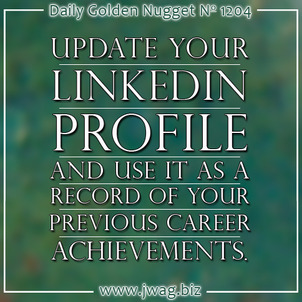
In this edition of #ThrowbackThursday I'm jumping all the way back to Nugget Number 101. The topic was getting started on LinkedIn.
LinkedIn has tried to reinvent itself a few times since that post on December 13, 2010, so it's time I talk about it again. Ironically, while on a coaching call with one of my jewelers the other day, he asked me how old customers could find him now that he works at, and is in the process of purchasing a different jewelry store. I recommended he set up a LinkedIn account.
What is LinkedIn?
LinkedIn has established itself as the professional network where your profile is more than just listing your hometown, relatives, and life events. Instead, you flesh out your entire working career, including details of every job you ever had every article you ever published, minor and major career certifications and achievements, and a whole lot more.
You can provide details of past jobs even if those companies are no longer in business, and that's a great way for old customers to find you.
More than just a profile, LinkedIn is your online professional resume.
Why LinkedIn?
Many business owners don't feel the need for a LinkedIn resume because, after all, they have no intention of closing their business to work for someone else.
But that's not the point.
Google gives LinkedIn a lot of organic ranking weight. If it exists, a LinkedIn resume will always appear in the first 3 organic places when I search for someone's name. This can be a valuable search tool for old customers who want to reconnect with you after you've changed jobs.
Even more important than the ability to connect with customers is the ability to connect with business contacts and other industry associates. Imagine you are handing out business cards at a networking event, or even a trade show. There's only so much information you can squeeze on a business card before it turns into a cluttered mess. Include your LinkedIn account on your business card if it's really important for new networking connections to understand your background more than knowing what you currently do.
Typical trade shows or networking events only allow for an exchange of business cards and a 2 or 3 minutes of conversation with someone. It's a good idea to have an elevator pitch prepared for those terse networking moments, and then invite the person to visit your LinkedIn profile.
LinkedIn Groups
I have very conflicted feelings about LinkedIn Groups; at the same time, they are my favorite yet least liked area of LinkedIn.
Groups are a good place for people to participate in business conversations. You won't find cat photos or comments about the weather, but you will find topics that relate to your job. People share topics that they feel will benefit other people with similar jobs.
On the other hand, the reason I dislike LinkedIn Groups is because far too many of them are set up and abandoned. Most groups don't require approval to join, and many of them are unmoderated, allowing for spammers to post their latest solicitation.
Find a few groups that would be beneficial to your career and pay attention to them. Every once in a while you'll learn something new.
LinkedIn Connections
They're not called friends, or fans, or followers... on LinkedIn we call them connections. Business connections.
LinkedIn was founded on the principal that you could connect with people you knew through business, and that's all you used it for. LinkedIn imposed an interstitial "how do you know this person" question to discourage you from making connection requests with people you don't know.
Today it's much easier to find business connections of people you already know, and those with whom you'd like to eventually meet or work with.
Additionally, requesting a connection with someone is also a good way to make someone aware of you and the work you do. Several of my best business relations were established through LinkedIn as a method of first introduction.
Trolls and Spammers
It is my recommendation that you accept the invitation to connect with other people when you receive them, but you should always be wary.
I've received a countless number of requests from people far outside my industry and from other countries. The other industry requests usually turn out to be legitimate, but more often than not the people from other countries are always trying to sell me something.
For example, on a weekly basis, I receive at least 1 connection request from an employee of a legitimate jewelry business in India. Because I invite all of my readers to connect with me socially I used to accept all connection requests without vetting the profile. Sure enough, every time I'd accept a connection request from a gemstone vendor in India I would immediately get an email through LinkedIn with their latest parcel sizes and prices.
I usually reply with a cordial message telling them that I'm a jewelry industry professional and not a retailer or designer. That was my soft way of telling them that I'm not interested. I disconnected with them if they persisted, which they often did.
Now, instead of blithely accepting every connection request, the moment it takes to quickly review someone's profile will save me a lot of time and aggravation later.
While LinkedIn is good to build connections for future business, don't use it as a platform to spam your services. Instead, fill out your profile as much as you are willing, and use it to share your knowledge with others.








